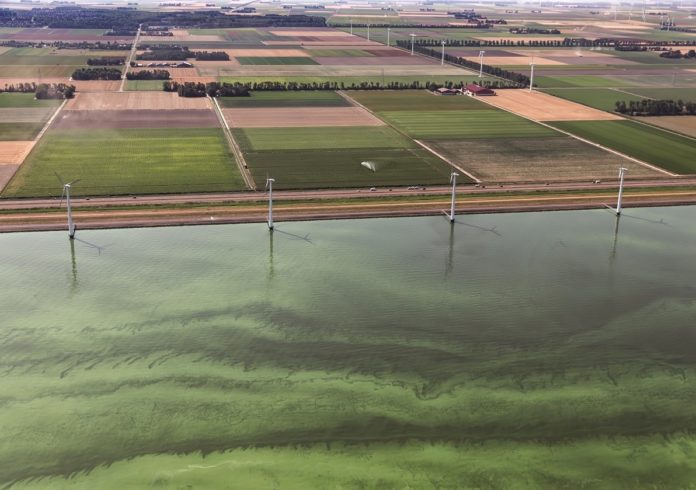By Lis Stedman
The proposed “Nitrogen for Life” roadmap for action on nitrogen challenges – agreed at the recent UN member state meeting in Sri Lanka – envisages a far-reaching and comprehensive global assessment on nitrogen cycling that would cover policy, implementation, regulation and the science involved.
The Colombo Declaration on Sustainable Nitrogen Management has the ambition of halving nitrogen waste by 2030. While nitrogen is a critical building block for life, when overused it negatively impacts the environment and is contributing to the climate crisis.
Nitrogen is ubiquitous. It comprises more than 78% of the atmosphere and makes the earth suitable for life. Combined with hydrogen it forms ammonia (NH3), the raw material for most nitrogen fertilisers but also a major cause of eutrophication. In combustion, nitric oxide (NO) and nitrogen dioxide (NO2) are formed, which are harmful air pollutants. Nitrate (NO3) is a product of wastewater that is also widely used in both fertilisers and explosives. Nitrous oxide (N2O) is a potent greenhouse gas.
In the invitation to the high-level dialogue, the then Sri Lankan president, Maithripala Sirisena, said: “The evidence is clear in that the air we breathe, the water we drink, the food we eat, the soil we invade, and the oceans regulating global temperature enabling our bodies to function, are being rapidly polluted.”
“If we are going to raise nitrogen up the agenda, then we need to sound the alarm loud and clear”
UNEP deputy executive director Joyce Msuya noted: “The campaign we have launched here today is so crucial. If we are going to raise nitrogen up the agenda, then we need to sound the alarm loud and clear. Once we have grabbed the world’s attention there is so much that can be done. And there are promising signs that some nations are already starting to wake up to the problem.”
In their final statement, member states recognised the urgency of tackling nitrogen management in meeting biodiversity goals, while appreciating the huge economic opportunities in reducing the reactive nitrogen that is wasted each year, as well as acknowledging the issue of eutrophic zones, which affect fishing and tourism.
Nitrogen expert Mark Sutton, of the UK’s Centre for Ecology and Hydrology (CEH), calls the gas “the godfather of pollution”. As a way of reducing it as part of the circular economy, he advocates that old gas is reused.
Since the 1950s, the amount of nitrogen compounds in the world has doubled, thanks to mass produced fertilisers and the boom in motor vehicles and heavy industry. CEH has been leading the International Nitrogen Management System (INMS) since its launch in 2016 on behalf of UNEP, in partnership with the International Nitrogen Initiative.
The aim of the initiative is to link the five aspects of the acronym WAGES – water, air, greenhouse gases, ecosystems, and soils/stratospheric ozone depletion – bringing together people from these disciplines, which are traditionally separate. Sutton has cited an example of the way this separation can confuse actions: climate scientists saying animals should be brought inside to prevent emission of harmful nitrous oxide, while air experts are saying that the animals should be in the field, or else ammonia emissions will rocket. He has called this situation “an example of two parallel universes that don’t talk to each other and yet, funnily, it’s the same nitrogen that’s linking them all”.
Coordinating initiatives
To bring the various specialisms together, the INMS is attempting to establish a coordination mechanism, under UNEP’s auspices, where all the different UN conventions on air, land, water, climate and stratospheric ozone will work together to complement their efforts to reduce nitrogen without interfering in each other’s mandates.
The expectation is that countries will want to bring this mechanism before the fifth UN Environment Assembly in 2021, to be held in Nairobi, Kenya. There is also a call to establish a working group for UNEP’s Committee of Permanent Representatives and agreement that UNEP is the right body to coordinate this as it has global reach and a mandate for all the WAGES issues.
Of the view that nitrogen pollution should be reduced by “denitrifying” nitrogen compounds in air or water thus converting useful forms of nitrogen back to pure atmospheric nitrogen, Sutton has said: “We don’t consider that very wise, because nitrogen compounds are a good resource if we can use them in the right way; that is, nutrient recycling.”
At the moment, all nitrogen for fertiliser is acquired as fresh nitrogen from the atmosphere, but if fertiliser companies obtained nitrogen from the nitrate in wastewater or nitrogen oxides from an industrial chimney, tonnes of pollutants would be captured while generating a circular economy for nitrogen.
Looking back to look forward
Sutton has used the example of 19th-century Paris, where, before the invention of the flush toilet, an authority would collect biosolids. These would be taken to a factory where the ammonia would be separated out and mixed with sulphuric acid to create ammonium sulphate fertilisers – around 2000 tonnes were produced every year.
He has said: “If we add up all the nitrogen pollution lost in the world – 200 billion tonnes – putting the health, ecosystem and climate costs aside, we can calculate the potential cash resource by multiplying the pollution quantity by the fertiliser price. At $1 per kilogramme, this leaves you with $200 billion a year of resource to mobilise huge economic innovation.
“All the technologies at the moment are using energy to destroy the nitrogen resource. A catalytic converter on a car destroys vehicle emissions, but imagine if we harvested them. It’s about changing the mindset. And we’re in the early stages of doing that, but it will take different industries and scientists to work together to succeed.”








